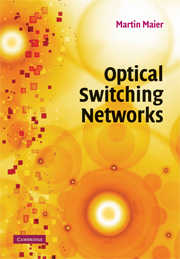Book contents
- Frontmatter
- Contents
- List of illustrations
- List of tables
- Preface
- Acknowledgments
- Part I Introduction
- 1 Historical overview of optical networks
- 2 Optical switching networks
- 3 Building blocks
- 4 Summary
- Part II Optical wide area networks
- Part III Optical metropolitan area networks
- Part IV Optical access and local area networks
- Part V Testbeds
- Bibliography
- Index
2 - Optical switching networks
from Part I - Introduction
Published online by Cambridge University Press: 10 May 2010
- Frontmatter
- Contents
- List of illustrations
- List of tables
- Preface
- Acknowledgments
- Part I Introduction
- 1 Historical overview of optical networks
- 2 Optical switching networks
- 3 Building blocks
- 4 Summary
- Part II Optical wide area networks
- Part III Optical metropolitan area networks
- Part IV Optical access and local area networks
- Part V Testbeds
- Bibliography
- Index
Summary
We have already seen that optical networks come in a large number of various flavors. Optical networks may have different topologies, may be transparent or opaque, and may deploy time, space, and/or wavelength division multiplexing (TDM, SDM, and/or WDM). They may comprise tunable devices, for example, tunable transmitters, tunable optical filters, and/or tunable wavelength converters (TWCs). Furthermore, to improve their flexibility optical networks may make use of reconfigurable optical add-drop multiplexers (ROADMs) and/or reconfigurable optical cross-connects. We will use the term optical switching networks to refer to all the various types of flexible and reconfigurable optical networks that use any of the aforementioned multiplexing, tuning, and switching techniques. Thus, optical switching networks are single-channel or multichannel (WDM) networks whose configuration can be changed dynamically in response to varying traffic loads and network failures by controlling the state of their tunable and/or reconfigurable network elements accordingly. Optical switching networks are widely deployed in today's wide, metropolitan, access, and local area networks and can be found at every level of the existing network infrastructure hierarchy.
End-to-end optical networks
Optical switching networks have been commonly used in backbone networks in order to cope with the ever-increasing amount of traffic originating from an increasing number of users and bandwidth-hungry applications. As shown in Fig. 2.1, optical switching networks can be found not only in wide area long-haul backbone networks but they also become increasingly the medium of choice in metro(politan), access, and local area networks (Berthelon et al., 2000). As a matter of fact, both telcos and cable providers are steadily moving the fiber-to-copper discontinuity point out toward the end users at the network periphery.
- Type
- Chapter
- Information
- Optical Switching Networks , pp. 19 - 30Publisher: Cambridge University PressPrint publication year: 2008



